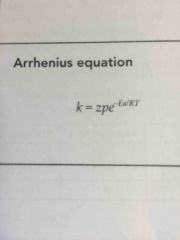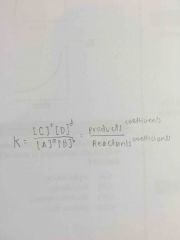![]()
![]()
![]()
Use LEFT and RIGHT arrow keys to navigate between flashcards;
Use UP and DOWN arrow keys to flip the card;
H to show hint;
A reads text to speech;
53 Cards in this Set
- Front
- Back
- 3rd side (hint)
|
Mass |
Kilogram (kg) |
|
|
|
Length |
Meter (m) |
|
|
|
Time |
Second (s) |
|
|
|
Electric current |
Ampere (A) |
|
|
|
Temperature |
Kelvin (K) |
|
|
|
Luminous intensity |
Candela (cd) |
|
|
|
Amount of substance |
Mole (mol) |
|
|
|
Amount of substance |
Mole (mol) |
|
|
|
Mega |
M (10^6) |
|
|
|
Kilo |
K (10^3) |
|
|
|
Luminous intensity |
Candela (cd) |
|
|
|
Femto |
f (10^-15) |
|
|
|
Amount of substance |
Mole (mol) |
|
|
|
Mega |
M (10^6) |
|
|
|
Kilo |
K (10^3) |
|
|
|
Deci |
d (10^-1) |
|
|
|
Centi |
c (10^-2) |
|
|
|
Milli |
m (10^-3) |
|
|
|
Micro |
u (10^-6) |
|
|
|
Nano |
n (10^-9) |
|
|
|
Pico |
p (10^-12) |
|
|
|
Empirical formula |
Smallest ratio of whole numbers |
|
|
|
Molecular formula |
Exact number of elemental atoms |
|
|
|
Rate constant (k) is affected by what 3 things? |
1. Pressure (only for gases) 2. Catalyst (lower activation energy) 3. Temperature When any of these 3 increase, k increase. |
|
|
|
Arrhenius equation (rate constant) |
k = Ae^(-Ea/RT) |
|
|
|
Percent yield |
Actual yield/ Theoretical yield |
|
|
|
Bond with Dipole moment |
Polar |
|
|
|
Bond without dipole moment |
Non-polar |
|
|
|
Strongest dipole-dipole interaction |
Hydrogen bond (FON) |
|
|
|
To determine mass when given moles |
Moles = grams/atomic or molecular wt |
|
|
|
Elementary reaction |
Reaction that occurs in a single step. |
|
|
|
When can you use coefficients from balanced equation for exponent in the rate law? |
When equation is elementary |
|
|
|
What do catalysts do? |
Lower the activation energy |
|
|
|
Alpha decay |
Lose helium nucleus (mass change: -4) Change in atomic # (-2) |
|
|
|
Beta decay |
Neutron becomes proton, electron emitted or positron absorbed. No change in mass. Atomic number: +1 |
Breakdown or formation of a single neutron (n) |
|
|
Beta decay |
Breakdown or formation of a single neutron (n) |
|
|
|
What do catalysts do? |
Lower the activation energy |
|
|
|
Alpha decay |
Lose helium nucleus (mass change: -4) Change in atomic # (-2) |
|
|
|
Beta decay |
Neutron becomes proton, electron emitted or positron absorbed. No change in mass. Atomic number: +1 |
Breakdown or formation of a single neutron (n) |
|
|
Beta decay |
Breakdown or formation of a single neutron (n) |
|
|
|
Electron capture |
Capture if an electron and merging with proton to form a neutron |
|
|
|
What do catalysts do? |
Lower the activation energy |
|
|
|
Alpha decay |
Lose helium nucleus (mass change: -4) Change in atomic # (-2) |
|
|
|
Beta decay |
Neutron becomes proton, electron emitted or positron absorbed. No change in mass. Atomic number: +1 |
Breakdown or formation of a single neutron (n) |
|
|
Beta decay |
Breakdown or formation of a single neutron (n) |
|
|
|
Electron capture |
Capture if an electron and merging with proton to form a neutron |
|
|
|
Gamma decay |
Occurs with other types of radioactive decay. |
|
|
|
Can a catalyst alter the equilibrium or equilibrium constant of a reaction? |
No |
|
|
|
Positron emission |
Proton becomes neutron and positron is emitted (0, 1, e) |
|
|
|
Radioactive decay follows what order kinetics? |
1st order |
Reaction rate is directly proportional to a single reactant's concentration |
|
|
Arrhenius equation |

Back (Definition) |
|
|
|
The Law of Mass Action |

Back (Definition) |
|
|
|
Heisenberg Uncertainty Principle |

Back (Definition) |
|

